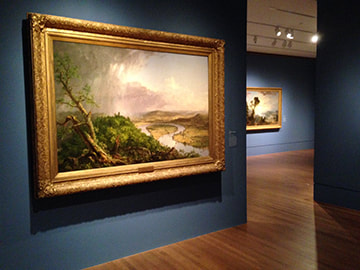 Thomas Cole and the Hudson River School of landscape painting are distinctly American, depicting the magnificent scenery of the United States in the first part of the 19th century. In “Thomas Cole's Journey Atlantic Crossings,” as exhibition at the Metropolitan Museum of Art, we wee how both Cole's art and his thinking was shaped by his experiences in Europe. Cole was born in northwest England in 1801. The Industrial Revolution was beginning and during his boyhood, Cole witnessed the transformation from a rural society to an industrial one with nature giving way to factories and crowded cities. For a time, the young Cole worked in the new mills designing patterns for textiles. However, in 1818, facing financial hardship in England, Cole's father moved the family to the United States. As a young man Thomas Cole traveled around Pennsylvania and Ohio painting portraits. Although he was largely self-taught, Cole achieved some success, exhibiting his work at the Philadelphia Academy. In 1825, Cole fell in love, not with a person but with the beauty of the undeveloped Catskill region of New York. He painted what he saw and although landscape painting was not a well-established genre in the young United States, his paintings drew attention and he was made a member of the National Academy. Cole decided that in order to develop as an artist he had to return to Europe. There he could study past masters and meet leading contemporary artists. His first stop was England. There was a long tradition of landscape painting in England. In addition, two contemporary painters were taking this genre in new directions. J. M. W. Turner was incorporating bold colors and unrestrained brush work to produce pieces that were significantly different than traditional landscape painting. His work has been described as a forerunner of modern art. Cole was impressed with some of Turner's paintings but was uncomfortable with both Turner's unkempt appearance and the wildness of his approach to art. Cole was much more comfortable with John Constable, with whom he became friends. Constable's large finished canvases were more traditional and constrained than Turner's works. However, the oil sketches that he made in preparation for his finished works have a great freedom of brush work and spontaneity. In addition to Cole's work, the exhibit displays some of the works by Turner and Constable that Cole saw or could have seen during his journey. Particularly interesting are the numerous Constable oil sketches. Cole did not just stay in England but traveled into France and Italy. In Italy, he enrolled in classes. made copies of works by Renaissance masters and made oil sketches of the Italian countryside and Roman ruins. As he had hoped, Cole's journey to Europe enhanced his artistic skills. In addition, he met many wealthy Americans while traveling abroad and received a number of commissions. As a result, his reputation also grew. Returning to the U.S., Cole had a successful exhibition of his European paintings in New York City. More commissions followed. He established a studio in the Catskills. Other artists also came to study under Cole and he shaped an artistic movement. Having seen the results of unfettered industrialization in England, Cole became very concerned that President Andrew Jackson was leading the country in the wrong direction. The beautiful American wilderness was in danger from unrestrained development. Cole took up his brushes to warn of the consequences. Thus, while Cole's works may appear to be just paintings of beautiful scenes, they are actually political pictures. Cole was saying that all this will be lost if you continue with such policies. It is still a timely message. In this vein, the exhibit presents a series known as “The Course of Empire.” In the various canvases, Cole shows the same landscape first in its wild state and then progressively through development into a classical city and eventually to the final ruin of civilization. Perhaps more more subtlety, Cole expresses much the same message in“The Oxbow,” which shows a pristine river valley about to be engulfed by a massive storm. Cole's works transcend their political message. He had mastered traditional landscape painting and used it to portray magnificent scenes. Furthermore, his ability to compose a scene so as to make it speak to a wide audience cannot be denied. Comments are closed.
|
AuthorRich Wagner is a writer, photographer and artist. Archives
November 2018
Categories
All
|

 RSS Feed
RSS Feed